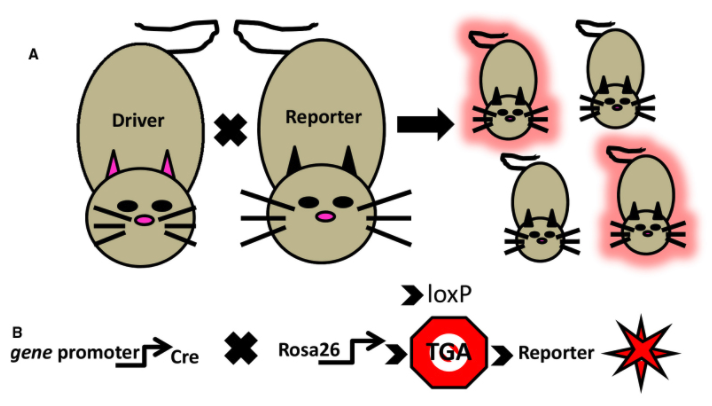Cre/LoxP | lineage tracing | fate map | 重组酶
2023年01月05日
研究小鼠必备!!!
没有这个Cre/LoxP系统,研究将无法具体(in vivo太泛),无法在特定时间里精准地在特定细胞里进行基因操纵,完美适配sorting,有了它,我们将指哪打哪,打哪指哪!!!
小鼠 + 谱系追踪 + 基因操纵,Cre-loxP真是神奇,同类的诺奖技术转座子、RNAi、CRISPR,发明者Nat Sternberg只活了53岁,其实是可以拿诺奖的。
Lgr5; tdT (WT) and Lgr5-ApcKO; tdT (Apc KO)
The key of Cre/LoxP system is two points. One is where is the cre, the gene before cre is the key marker gene (e.g., Wnt, Lgr5, Cdx2). The second one is what is surrounded by LoxP, this will be discard. The Tam induction is a key detail. Stop codon was used to repress tdT expression.
- Why not sort out Lgr5+ cell, but use this to indirectly sort tdT+ cells? 因为我们要研究的Apc KO的表皮细胞,而且我们需要对照,这是最好的设计。本质就是个双筛,一筛marker gene,二筛LoxP运作的细胞,这里一般用来KO,这个系统很灵活。
参考:
这项技术太重要了,做细胞发育的单细胞的不得不用。主要用途就是marking 表达过特定基因的子代细胞,比如Sox10标记的Neural crest,或者做conditional的KO。
同类技术:基因敲除,编辑等。
基本解释:
Cre是一个细菌的蛋白,可以切割带LoxP序列的DNA,LoxP的不同排列也会导致不同的结果。
Animals transgenic使用的小鼠都是转基因的:
- Sox10::CreERT2 (SER93) driver【注意写法,CreER就是融合蛋白】
- Rosa26EYFP or Rosa26Confetti reporters【就是Rosa26这个位点连一个荧光蛋白】
最终缩写 SER93|EYFP or SER93|Confetti,在tamoxifen刺激下就会激活。
什么是driver?什么是reporter?
driver就是指靠特定的promoter激活Cre的个体,reporter就是带有荧光蛋白的个体(正常时被终止密码子抑制表达),杂交后就会重组,形成带荧光的后代。

Genetic identification of cells using cre-lox driver: reporter methods.
(A) Mating a gene promotor containing “driver” mouse directed to express cre in a selective fashion to a cre-dependent “reporter” mouse yields offspring which may inherit the driver-reporter combination (red offspring) of genes. Those offspring which do not inherit the combination will not express the identification marker (non-fluorescent offspring).
(B) A currently used strategy is to cross a cre driver mouse to a mouse expressing a cre-sensitive element at a ubiquitously expressed locus like rosa26. At this locus is a Stop codon (Stop sign with TGA) flanked by loxP sites (indicated by arrows) designed to be excised by cre recombinase activity allowing expression of genetically encoded fluorescent reporters (red star symbol) in the target cell population.
Tamoxifen诱导的Cre/loxP
核心:形成了Cre/ER融合蛋白,在Tamoxifen的刺激下才有活性。
Tamoxifen (TAM)-inducible Cre/loxP is one of the most widely used inducible systems for gene regulation. This is in part due to the fact that it enables gene control both spatially and temporally. The inducible Cre/loxP estrogen receptor (ER) transgenic system is used to study both ubiquitous and tissue-specific gene function through the expression of Cre recombinase fused to the G525R mutant form of the mouse estrogen receptor 1 (Esr1) to create a Cre/ER fusion protein1,2.
Cre/ER recombinases remain unexpressed until activated by the TAM metabolite, which provides external and time-specific control of Cre activity.
Optimization of tamoxifen-induced Cre activity and its effect on immune cell populations
reporter
tdTomato
GFP
YFP
CFP
RFP
Confetti
H2B-mCherry
ROSA26是人和鼠里面的一个位置,可以理解为一个不表达蛋白的gene。
ROSA26 is a locus used for constitutive, ubiquitous gene expression in mice. It was first isolated in 1991 in a gene-trap mutagenesis screen of embryonic stem cells (ESCs). Over 130 knock-in lines have been created based on the ROSA26 locus.
The Rosa26 locus on chromosome 6 is frequently used for the integration of transgene constructs to achieve ubiquitous or conditional gene expression in mice. The Rosa26 transcript is spliced into three exons and ubiquitously expressed in all cell types and developmental stages, but not translated to a protein.
Efficient generation of Rosa26 knock-in mice using CRISPR/Cas9 in C57BL/6 zygotes
The mouse Rosa26 locus is particularly useful for genetic modification as it can be targeted with high efficiency and is expressed in most cell types tested.


【推荐】国内首个AI IDE,深度理解中文开发场景,立即下载体验Trae
【推荐】编程新体验,更懂你的AI,立即体验豆包MarsCode编程助手
【推荐】抖音旗下AI助手豆包,你的智能百科全书,全免费不限次数
【推荐】轻量又高性能的 SSH 工具 IShell:AI 加持,快人一步
· winform 绘制太阳,地球,月球 运作规律
· AI与.NET技术实操系列(五):向量存储与相似性搜索在 .NET 中的实现
· 超详细:普通电脑也行Windows部署deepseek R1训练数据并当服务器共享给他人
· 【硬核科普】Trae如何「偷看」你的代码?零基础破解AI编程运行原理
· 上周热点回顾(3.3-3.9)